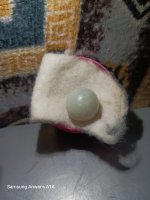Saleem Sana'a
New Member
- Joined
- May 10, 2025
- Messages
- 8
Hello,
I would greatly appreciate your help in identifying a pearl I own.
Here are some details:
- Size: Around 10 mm
- Shape: Round
- Surface: Slightly rough
- Color: Silvery white with strong luster
- It is not drilled or polished
- Location: Sana’a, Yemen
I’ve attached several photos taken under natural and artificial light. Please let me know your thoughts on:
1. Whether this appears to be a natural or cultured pearl
2. Any approximate value range
3. Whether it's worth sending for lab testing
Thank you so much for your time and expertise!
I would greatly appreciate your help in identifying a pearl I own.
Here are some details:
- Size: Around 10 mm
- Shape: Round
- Surface: Slightly rough
- Color: Silvery white with strong luster
- It is not drilled or polished
- Location: Sana’a, Yemen
I’ve attached several photos taken under natural and artificial light. Please let me know your thoughts on:
1. Whether this appears to be a natural or cultured pearl
2. Any approximate value range
3. Whether it's worth sending for lab testing
Thank you so much for your time and expertise!


